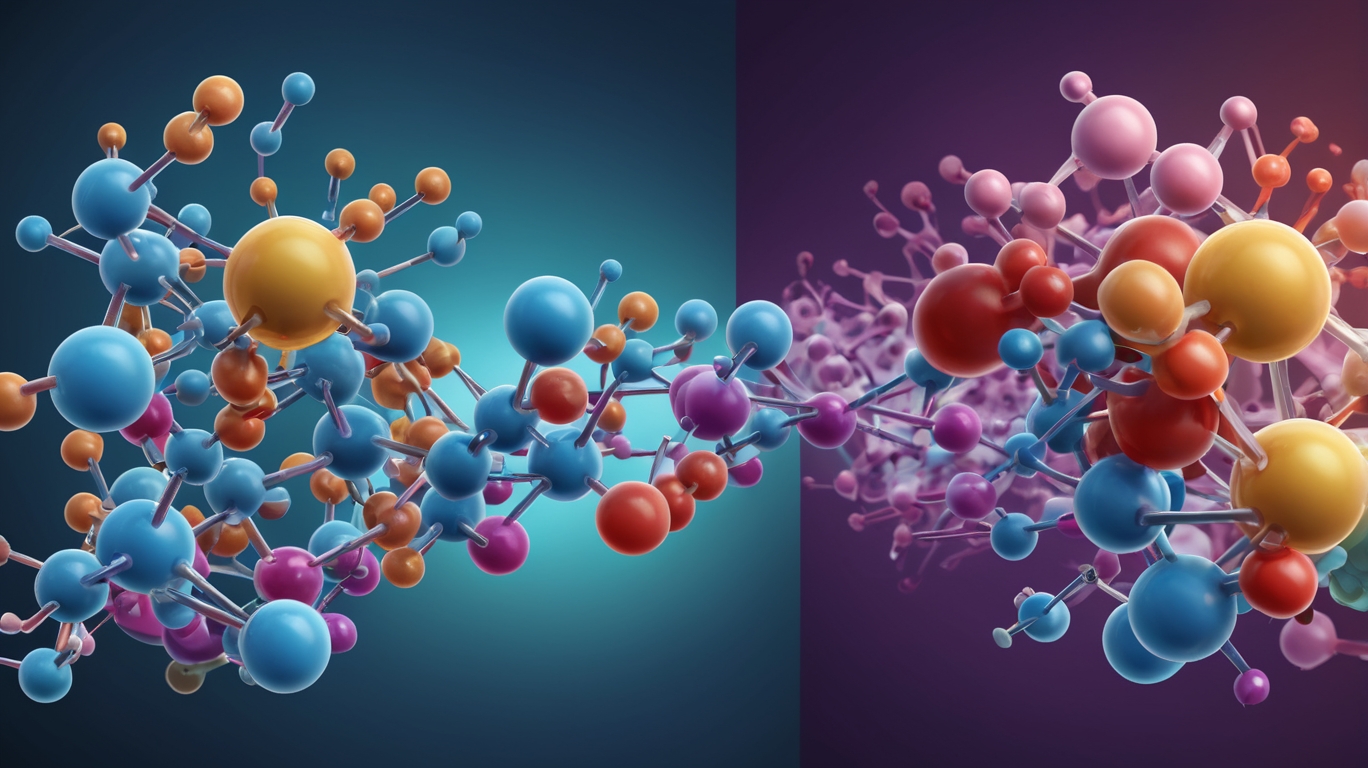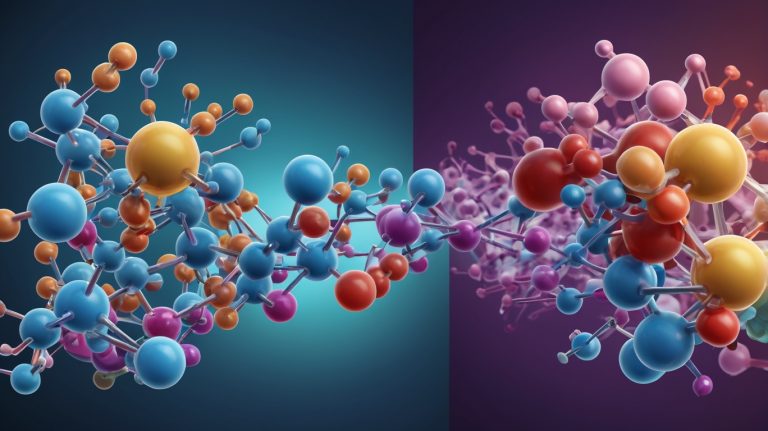If you’re curious about peptides and SARMs, you’re in the right spot. This guide will dive into the specifics of these compounds, exploring their benefits, mechanisms, and potential side effects. Let’s get started on this fascinating journey into the world of peptides and SARMs.
Contents
- 1 Peptides Defined
- 2 Understanding SARMs
- 3 Benefits of Using Peptides
- 4 Advantages of SARMs
- 5 Potential Side Effects
- 6 Comparing Peptides and SARMs
- 7 Legal Status and Regulations
- 8 How Peptides Work in the Body
- 9 Mechanism of Action for SARMs
- 10 Choosing Between Peptides and SARMs
- 11 Safety Considerations
- 12 Conclusion
Peptides Defined
Peptides are short chains of amino acids, the building blocks of proteins. They’re like the unsung heroes in the world of fitness and health. These little guys play a crucial role in various bodily functions, from muscle growth to skin health. In the realm of fitness peptides, they’re often used for muscle growth, recovery, and even anti-aging.
Peptides like collagen peptides and insulin-like growth factor 1 (IGF-1) are popular for their health benefits. They’re involved in peptide therapy, which can help with everything from joint health to immune support. Peptides are also used in peptide supplementation, providing benefits like improved skin elasticity and faster muscle repair. They’re versatile, with applications in bodybuilding, fat loss, and even cognitive enhancement.
Peptides are also used in research, with studies focusing on peptide stability, absorption, and delivery systems. They’re a hot topic in pharmacology and regenerative medicine, with ongoing clinical trials exploring their potential.
Understanding SARMs
SARMs, or Selective Androgen Receptor Modulators, are a class of compounds that are gaining popularity in the fitness world. They’re like the cool new kid on the block, offering benefits similar to anabolic steroids but with fewer side effects. SARMs work by selectively targeting androgen receptors in the body, promoting muscle growth and fat loss.
These compounds are often used for performance enhancement and hormone optimization. They’re popular among bodybuilders and athletes looking to gain an edge without the risks associated with traditional steroids but these offer a legal alternative. SARMs are also being studied for their potential in treating conditions like muscle wasting and osteoporosis.
One of the key advantages of SARMs is their ability to promote muscle growth without affecting other tissues. This selectivity makes them a promising option for those looking to enhance their physique without the unwanted side effects of steroids. However, it’s important to note that SARMs are still considered research chemicals, and their long-term effects are not fully understood.

Benefits of Using Peptides
Peptides offer a wide range of benefits, making them a popular choice for those looking to improve their health and fitness. One of the main advantages is their ability to promote muscle growth and recovery. Peptides like growth hormone-releasing peptides (GHRP) and IGF-1 are known for their muscle-building properties, making them a favorite among bodybuilders.
In addition to muscle growth, peptides also offer benefits for skin health. Collagen peptides, for example, can improve skin elasticity and reduce the appearance of wrinkles. Peptides are also used for joint health, with some studies suggesting they can help reduce inflammation and promote healing.
Peptides are also known for their role in fat loss. Certain peptides can help boost metabolism and promote fat burning, making them a popular choice for those looking to shed a few pounds. They’re also used for cognitive enhancement, with some peptides showing promise in improving memory and focus.
Advantages of SARMs
SARMs offer several advantages over traditional anabolic steroids. One of the main benefits is their selectivity, which allows them to target specific tissues without affecting others. This means you can enjoy the muscle-building benefits without the unwanted side effects associated with steroids.
Another advantage of SARMs is their potential for fat loss. These compounds can help increase metabolism and promote fat burning, making them a popular choice for those looking to improve their body composition. SARMs are also known for their ability to enhance performance, making them a favorite among athletes and bodybuilders.
In addition to their physical benefits, SARMs are also being studied for their potential in treating various medical conditions. Some research suggests they may be effective in treating muscle wasting, osteoporosis, and even certain types of cancer. However, it’s important to note that SARMs are still considered research chemicals, and their long-term effects are not fully understood.
Potential Side Effects
While peptides and SARMs offer numerous benefits, they also come with potential side effects. For peptides, the most common side effects include injection site reactions, such as redness or swelling. Some people may also experience headaches or nausea, but these are generally mild and temporary.
SARMs, on the other hand, can have more serious side effects. While they’re generally considered safer than anabolic steroids, they can still cause issues like liver damage, hormonal imbalances, and increased risk of heart disease. It’s important to use these compounds responsibly and under the guidance of a healthcare professional.
Both peptides and SARMs can also interact with other medications, so it’s important to discuss their use with your doctor. Additionally, because these compounds are often sold as research chemicals, there’s a risk of contamination or impurities. Always purchase from reputable suppliers and ensure the products are tested for purity.
Comparing Peptides and SARMs
When it comes to choosing between peptides and SARMs, it really depends on your goals. Peptides are great for those looking to improve muscle growth, recovery, and overall health. They’re also a good option for those interested in anti-aging and skin health.
SARMs, on the other hand, are ideal for those looking to enhance performance and body composition. They’re a popular choice among athletes and bodybuilders due to their muscle-building and fat-burning properties. However, it’s important to note that SARMs are still considered research chemicals, and their long-term effects are not fully understood.
Both peptides and SARMs have their pros and cons, so it’s important to weigh the benefits and risks before making a decision. Consider your goals, health status, and any potential side effects when choosing between these compounds.
Legal Status and Regulations
The legal status of peptides and SARMs varies depending on the country. In the United States, peptides are generally considered legal for research purposes, but their use in supplements or as drugs is regulated by the FDA. Some peptides may be available by prescription for specific medical conditions.
SARMs, on the other hand, are not approved for human use by the FDA. They’re considered research chemicals and are often sold for research purposes only. However, they’re sometimes marketed as dietary supplements, which can lead to legal issues.
It’s important to be aware of the legal status of these compounds in your country and to purchase from reputable suppliers. Always ensure that the products are tested for purity and comply with local regulations.
How Peptides Work in the Body
Peptides work in the body by interacting with specific receptors and signaling pathways. They can mimic the action of hormones or other signaling molecules, leading to various physiological effects. For example, growth hormone-releasing peptides (GHRP) stimulate the release of growth hormone, promoting muscle growth and recovery.
Peptides can also influence metabolism, immune function, and inflammation. Some peptides, like thymosin beta-4, are involved in wound healing and tissue repair. Others, like BPC-157, are known for their anti-inflammatory properties and ability to promote joint health.
The effectiveness of peptides depends on factors like their structure, stability, and delivery method. Peptide injections are a common method of administration, but research is ongoing to develop more efficient delivery systems.
Mechanism of Action for SARMs
SARMs work by selectively binding to androgen receptors in the body. This selective action allows them to promote muscle growth and fat loss without affecting other tissues. Unlike traditional steroids, which can have widespread effects, SARMs target specific tissues, reducing the risk of side effects.
The mechanism of action for SARMs involves modulating the activity of androgen receptors, which play a key role in muscle growth and development. By activating these receptors, SARMs can increase protein synthesis and promote muscle hypertrophy.
SARMs are also known for their ability to enhance performance and endurance. They can increase energy levels and improve recovery, making them a popular choice among athletes and bodybuilders.
Choosing Between Peptides and SARMs
Choosing between peptides and SARMs depends on your individual goals and preferences. If you’re looking to improve muscle growth, recovery, and overall health, peptides may be the better option. They’re also a good choice for those interested in anti-aging and skin health.
On the other hand, if you’re focused on enhancing performance and body composition, SARMs may be more suitable. They’re known for their muscle-building and fat-burning properties, making them a popular choice among athletes and bodybuilders.
It’s important to consider the potential side effects and legal status of these compounds before making a decision. Always consult with a healthcare professional and purchase from reputable suppliers to ensure safety and quality.
Safety Considerations
When using peptides and SARMs, safety should be a top priority. Both compounds can have potential side effects, so it’s important to use them responsibly and under the guidance of a healthcare professional.
For peptides, the most common side effects include injection site reactions and mild symptoms like headaches or nausea. It’s important to follow proper injection techniques and hygiene practices to minimize the risk of infection.
SARMs can have more serious side effects, including liver damage and hormonal imbalances. It’s crucial to monitor your health and consult with a healthcare professional if you experience any adverse effects.
Additionally, because these compounds are often sold as research chemicals, there’s a risk of contamination or impurities. Always purchase from reputable suppliers and ensure the products are tested for purity.
Conclusion
In conclusion, peptides and SARMs offer exciting possibilities for those looking to enhance their health and fitness. Peptides are versatile compounds that can promote muscle growth, recovery, and overall well-being. They’re also known for their anti-aging and skin health benefits. On the other hand, SARMs provide a targeted approach to muscle building and fat loss, making them a popular choice among athletes and bodybuilders. However, it’s important to consider the potential side effects and legal status of these compounds before using them. Always consult with a healthcare professional and purchase from reputable suppliers to ensure safety and quality. Whether you choose peptides or SARMs, both offer unique benefits that can help you achieve your fitness goals.
Frequently Asked Questions
Are peptides and SARMs safe to use?
Peptides and SARMs can be safe when used responsibly and under the guidance of a healthcare professional. However, they can have potential side effects, so it’s important to monitor your health and consult with a doctor if you experience any adverse effects.
Can peptides and SARMs be used together?
Some people choose to use peptides and SARMs together to maximize their benefits. However, it’s important to consult with a healthcare professional before combining these compounds to ensure safety and effectiveness.
Where can I buy peptides and SARMs?
Peptides and SARMs are often sold as research chemicals, so it’s important to purchase from reputable suppliers. Look for companies that test their products for purity and comply with local regulations. Always ensure the products are safe and of high quality.

